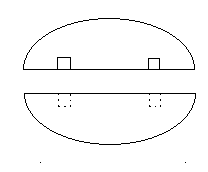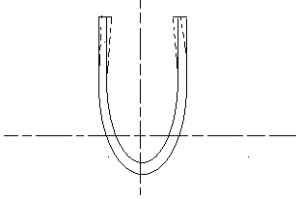This set of Engineering Materials & Metallurgy Multiple Choice Questions & Answers (MCQs) focuses on “Pattern Making”.
1. Which pattern is demonstrated in the following figure?

a) Split pattern
b) Skeleton pattern
c) Segmental pattern
d) Match plate pattern
View Answer
Explanation: The important processes involved in the foundry are pattern making, mold making, and casting. A pattern is that part onto which the molten metal is poured to produce a casting. The given figure illustrates a split pattern type in pattern making process.
2. Why is split pattern preferred over solid pattern?
a) High structural strength
b) Simple geometry
c) High operable temperature
d) Requires lesser time
View Answer
Explanation: A pattern having a complex geometry like one seen in the solid or single-piece pattern is difficult to remove from the mold. Therefore, a split pattern eliminates the difficulty as different sections are produced separately.
3. How are the different sections of a split pattern joined?
a) Weld
b) Locknut
c) Dowel pin
d) Flange coupling
View Answer
Explanation: A split pattern is preferred over a solid pattern as it is easier to remove from the mold. Two or three different sections are produced separately in this process. These separate sections are then joined together by using dowel pins.
4. A match plate is made of _________
a) Stainless steel
b) Wood
c) Copper
d) Teflon
View Answer
Explanation: A match plate pattern is made in two halves mounted on both sides called match plate. This match plate is made of either aluminum or wood. The match plate is placed between the cope and the drag flasks by using locating pins.
5. What are sweep patterns used for?
a) Piston rings for IC engine
b) Circular castings in loam molding
c) Symmetrically shaped castings
d) Drainage fittings
View Answer
Explanation: Sweep patterns are used to generate surfaces of revolution like a cylinder and sphere. They are used to make large and circular castings in loam molding. Piston rings of IC engine can be made by match plate pattern, whereas drainage fittings can be made by using a shell pattern.
6. What is the maximum allowable amount of moisture on wood?
a) 10%
b) 30%
c) 45%
d) 55%
View Answer
Explanation: Wood is the most commonly used material for pattern making. It should not contain moisture of more than 10% in order to avoid warping and distortion. Metal spray coating up to 0.25 mm thick may be given on the pattern. Additionally, zinc and aluminum are used for coating the metals on the wooden surface.
7. What is the typical machining allowance for aluminum?
a) 0.5 mm
b) 1.6 mm
c) 2.4 mm
d) 3.0 mm
View Answer
Explanation: The extra size given to a matter for machining purpose is called machining or finishing allowance. For aluminum of 0-300 mm, an allowance of 1.6 mm is permitted. For aluminum of 0-600 mm, the typical machining allowance is 3.2 mm.
8. Since wood is expensive for larger castings, __________ is used instead of a full pattern.
a) Loose piece pattern
b) Segmental pattern
c) Match plate pattern
d) Skeleton pattern
View Answer
Explanation: For larger casting of a simple shape in a solid pattern, a large amount of wood is required. This, therefore, increases the cost of operation. In such cases, skeleton pattern is used, which is simply a ribbed frame of the desired casting.
9. What kind of allowance is seen in this figure?

a) Drafting allowance
b) Camber allowance
c) Machining allowance
d) Shrinkage allowance
View Answer
Explanation: The casting may distort or warp during cooking if it is an irregular shape. Due to this distortion, the casting may bend. To avoid this, the shape of the pattern is slightly bent into the opposite direction. This is the distortion or camber allowance.
Sanfoundry Global Education & Learning Series – Engineering Materials & Metallurgy.
To practice all areas of Engineering Materials & Metallurgy, here is complete set of 1000+ Multiple Choice Questions and Answers.
If you find a mistake in question / option / answer, kindly take a screenshot and email to [email protected]
- Check Engineering Materials Books
- Practice Metallurgical Engineering MCQs
- Check Metallurgical Engineering Books
- Apply for Metallurgical Engineering Internship
